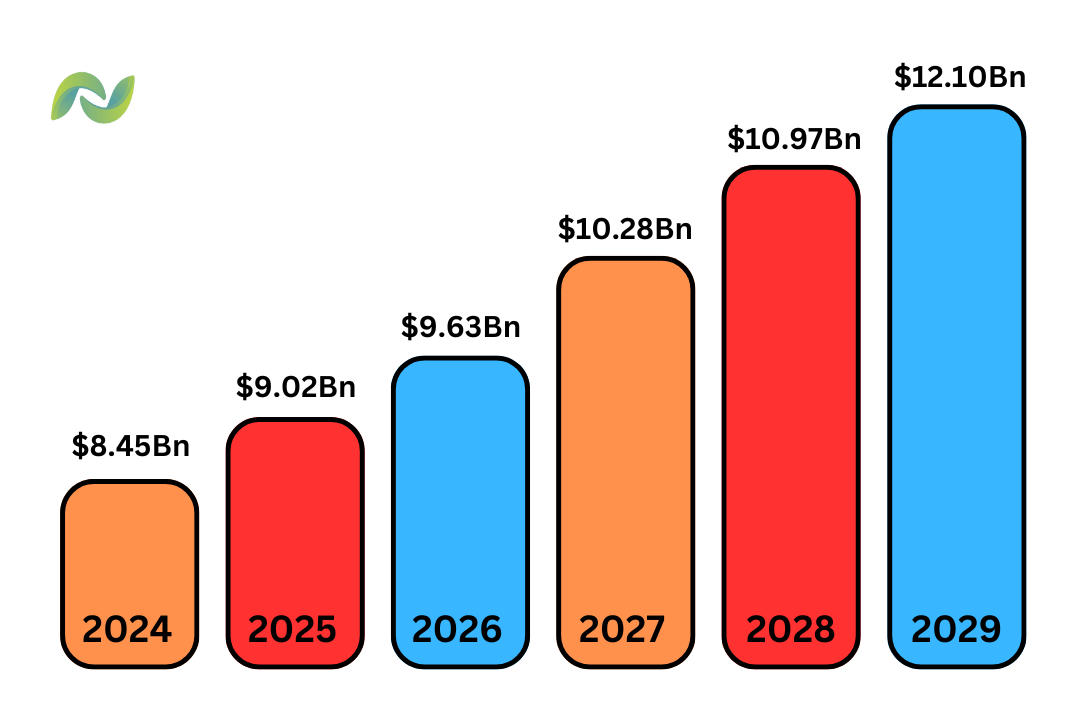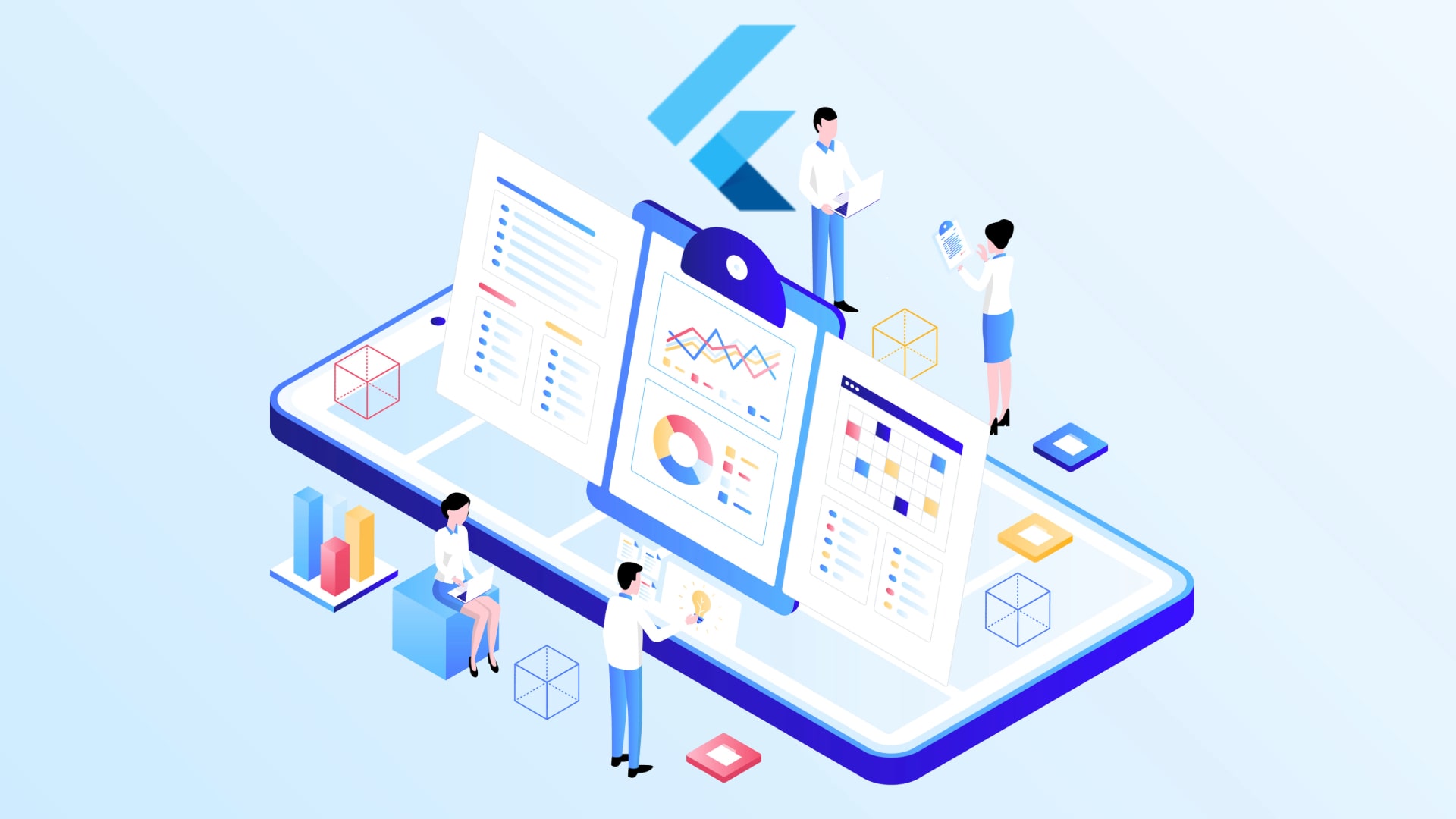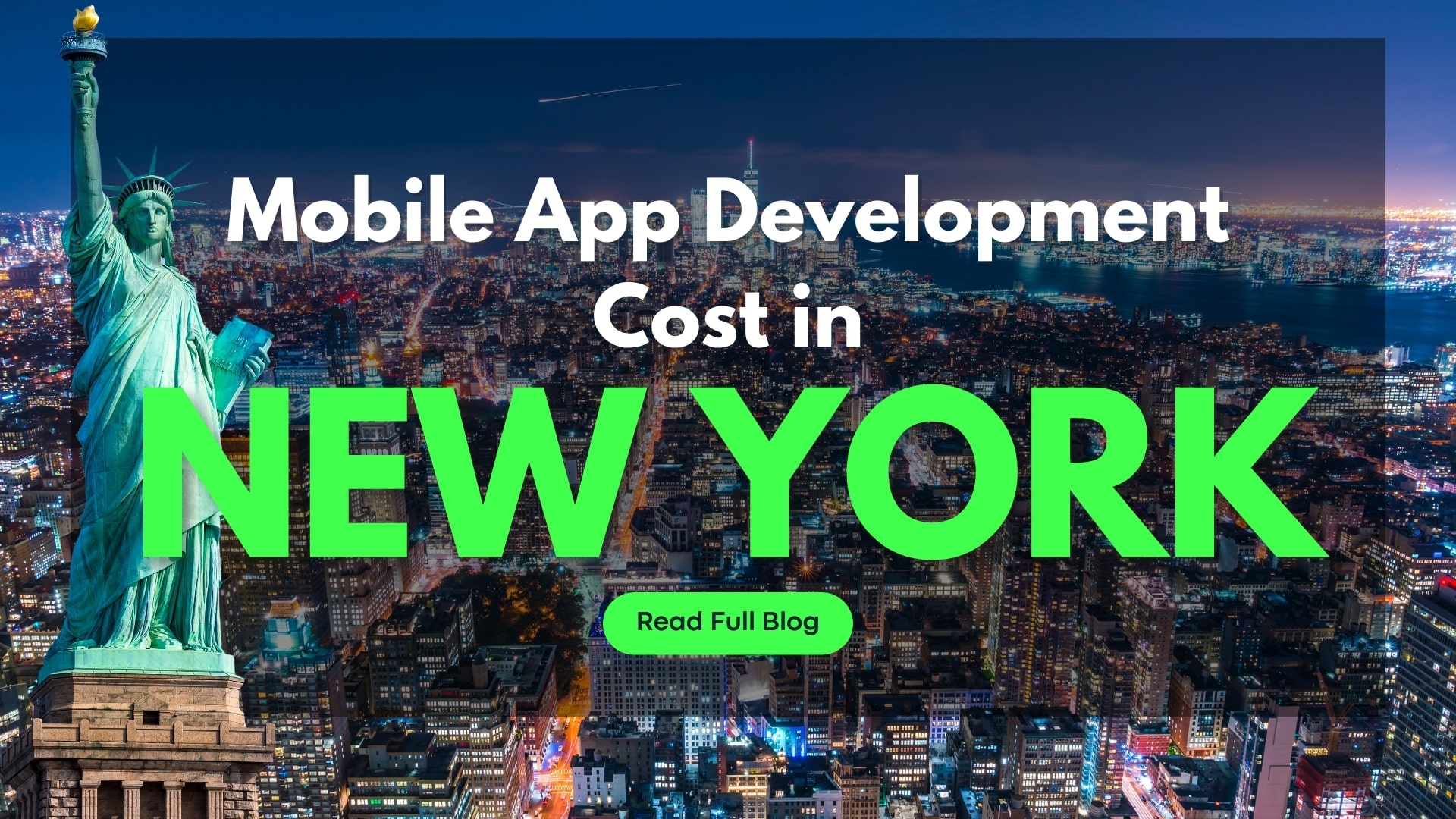Mobile App Development Cost in Australia (2025)
Australia is a growing marketplace for mobile app development companies in 2025. Mobile applications have become an essential aspect of people’s lives, with more than 20 million active users in Australia. Businesses are moving themselves online while focusing on establishing a strong digital presence and testing innovative ways to provide value to their customers. But developing a mobile app is a sophisticated process. In this guide, we will go through the key factors that influence mobile app development cost in Australia in 2025.
Table of Contents
ToggleMarket Statistics of Mobile App Development in Australia in 2025

As per the report by Statista, the market cap of the app development industry in 2024 was $9.45 billion and reached $9.02 billion in 2025. With a CAGR of 6.74%, the market cap is expected to reach $12.10 billion in 2029.
Types of Mobile Apps and Their Development Costs
[1] Native Apps
Native Applications are one of the most popular types of apps. These apps are specifically designed and developed to work on a particular platform, such as Android and iOS. One of the advantages of native apps is that these apps are fully optimized to work on any device with the platform it is designed for and properly utilize the hardware resources to maximize performance. The only drawback is that these apps are expensive to develop and maintain. Cost: AU$ 8,316 to AU$ 133,059 or more ($5,000 to $80,000 or more).
[2] Web Applications
Web applications are cloud-based applications that can be accessed by web browsers. Web apps are highly responsive websites that are hosted on a website, and users can access them using a web browser and the internet. One of the advantages of the web application is that it does not require and download or installation on the device as it is stored on a server. Web apps can be accessed by any device, such as a smartphone, tablet, or laptop. The major disadvantage is that web apps cannot run without the internet. Cost: AU$ 4,989 to AU$ 49,897 or more ($3,000 to $30,000 or more).
[3] Cross-Platform Apps
Cross-platform applications are now being widely used by businesses due to their multiple-device compatibility. Cross-platform applications are designed and developed using a single codebase for a single app to run on various platforms, such as Android or iOS, or as a web app. Technologies such as Flutter are used to develop cross-platform apps. Since a single codebase is used, the overall cost of developing the app for multiple devices is greatly reduced due to factors such as fewer resources, less time to develop, etc. Cost: AU$ 16,632 to AU$ 83,162 ($10,000 to $50,000).
[4] Progressive Web Apps
Progressive Web Apps are a highly optimized and responsive type of applications that run on a web browser but offer near-native performance. PWAs aim to offer a mobile app-like experience to users and offline functionality like native applications. PWAs are also cross-platform compatible and can run on any platform, such as Android and iOS. Cost: AU$ 16,632 to AU$ 49,897 ($10,000 to $40,000).
[5] Gaming Apps
Gaming apps dominate the Play Store and App Store due to being one of the most popular forms of entertainment apps. Video games are either in 2D or 3D. 2D games are simple to make and offer a casual and simple gaming experience, while 3D games offer many more functionalities, such as multiplayer gameplay, high-quality graphics, etc. Games with VR support come with an increased price tag. Cost: AU$49,897 to AU$582,135 or more ($30,000 to $350,000 or more).
Factors Influencing Mobile Application Development Cost in Australia
[1] App Features and Complexity
Any mobile app that has a lot of features will be highly complex to design and develop. Basic features such as push notification, in-app messaging search option cost less to develop, while advanced features such as AI/ML integration, security features, and offline functionality require more resources and time to develop and hence cost more.
[2] Platform Selection
The selection of the right platform plays a crucial role in determining the cost to develop an app. A native app that runs on a single platform, such as Android or iOS, due to the more time and resources required to develop it. Opting cross-platform would be a great choice since a single codebase is required to develop the app for several platforms at once, thus reducing the overall development costs.
[3] UI/UX Design and Complexity
A great user interface is what engages the users on your app. A simple UI with basic animations and features would cost less than a complex UI with advanced features, custom animations, etc, due to more time and resources involved in developing it.
[4] Location of the Development Team
The location of the development team is also an important factor in deciding the application development costs. A team situated in the USA would charge more than a team situated in Southeast Asian countries. The expertise and size of the team also matter. A small team would develop the app slowly but cost less than a big team that develops the app much faster.
[5] Third-Party Integration
Third-party integration is a cost saver as it eliminates the need to develop custom APIs and tools needed to increase the overall features and functionalities of the application. APIs such as payment gateway, maps API, etc, require subscription or licensing fees that are less than the overall development cost of custom APIs.
[6] Maintenance and Updates
Every app requires regular maintenance to keep it running fine for a long time without any issues. With changing time and market trends, the app must be equipped with the latest features and functionalities to keep up with the trends. Regular updates and maintenance would cost every month, and it is a necessary factor.
[7] Security Features
Data security and user data privacy are the utmost important factors to consider in mobile app development costs. Security features such as biometric login, 2-factor authentication, and end-to-end encryption are necessary and require time and resources to develop, hence contributing to the overall development costs.
[8] Marketing and Deployment Costs
After the app is developed, it needs to be deployed on the App Store or the Play Store. Publishing of the app requires fees and depends on the platform. Then, extensive marketing campaigns in the form of social media ads and Google ads should be run to promote the app to reach a wider audience. Marketing is cost-intensive, so choose it carefully.
Cost of Essential and Popular Features in Mobile Apps
[1] Basic Features
{1} User Profile
- Description: Users can update or create their profiles in the application.
- Cost: AU$ 831 to AU$ 1,496 ($500 to $900).
{2} Basic Reporting and Analytics
- Description: Get a report of trends and patterns to make better decisions.
- Cost: AU$ 1,330 to AU$ 2,494 ($800 to $1,400).
{3} Push Notifications
- Description: Get timely alerts of important reminders and offers, etc.
- Cost: AU$ 665 to AU$ 1,663 ($400 to $1,000).
{4} Offline Functionality
- Description: Users can use the app’s features even without the internet.
- Cost: AU$ 1,663 to AU$ 2,827 ($1,000 to $1,700).
{5} Search Option
- Description: Users can search for anything within or outside the app using the internet.
- Cost: AU$ 831 to AU$ 1,995 ($500 to $1,200).
[2] Popular Features
{1} Payment Gateway
- Description: Execute transactions securely through the app.
- Cost: AU$ 2,494 to AU$ 5,821 ($1,500 to $3,500).
{2} In-App Messaging
- Description: Users can chat through the built-in messaging feature.
- Cost: AU$ 2,162 to $ AU$ 2,494 ($1,300 to $2,500).
{3} Social Media Sharing
- Description: Share your achievements on social media through the app.
- Cost: AU$ 831 to AU$ 1,995 ($500 to $1,200).
{4} Map and Navigation
- Description: Get access to the map and navigation features within the app.
- Cost: AU$ 2,162 to AU$ 5,156 ($1,300 to $3,100).
{5} AR/VR Integration
- Description: Leverage Augmented Reality and Virtual Reality for a next-level experience.
- Cost: AU$ 3,326 to AU$ 10,811($2,000 to $6,500).
[3] Advanced and Complex Features
{1} AI/ML Integration
- Description: AI/ML Models help in automating tasks and solving complex problems.
- Cost: AU$ 5,821 to AU$ 14,137 ($3,500 to $8,500).
{2} Voice Commands
- Description: Control your app using voice commands.
- Cost: AU$ 4,158 to AU$ 7,484 ($2,500 to $4,500).
{3} Video Streaming
- Description: Users can live stream content within the app.
- Cost: AU$ 4,989 to AU$ 8,316 ($3,000 to $5,000).
{4} Multi-Language Support
- Description: Select the preferred language for using the app.
- Cost: AU$ 2,494 to AU$ 4,989 ($1,500 to $3,000).
{5} Security Features
- Description: Robust security features, such as 2-factor authentication, ensure data protection.
- Cost: AU$ 4,989 to AU$ 14,969 ($3,000 to $9,000).
Latest Technologies Affecting the Mobile App Development Cost in Australia
Technologies
[1] Artificial Intelligence and Machine Learning
- Description: AI and ML enable automation and development of smart apps and chatbots.
- Cost: AU$ 11,642 to AU$ 41,581 ($7,000 to $25,000).
[2] Internet of Things
- Description: IoT enables mobile apps to connect with smart devices.
- Cost: AU$ 16,632 to AU$ 49,897($10,000 to $30,000).
[3] Blockchain
- Description: Blockchain ensures secure transactions and transparency.
- Cost: AU$ 16632 to AU$ 41,581($10,000 to $25,000).
[4] Virtual Reality
- Description: VR enables users to explore the virtual world using their mobile devices.
- Cost: AU$ 33,264 to AU$ 99,794 ($20,000 to $60,000).
[5] Augmented Reality
- Description: AR overlays digital objects onto the real-world environment.
- Cost: AU$ 41,581 to AU$ 82,509 ($25,000 to $50,000).
[6] Quantum Security
- Description: Develop cryptographic measures to block attacks from quantum computers.
- Cost: AU$ 24,752 to AU$ 90,760 ($15,000 to $55,000).
Frameworks
[1] React Native
- Description: Used to develop cross-platform apps with a single codebase.
- Cost: AU$ 8,250 to AU$ 33,003 ($5,000 to $20,000).
[2] Flutter
- Description: Create cross-platform apps with reusable code for mobile and web.
- Cost: AU$ to AU$ ($7,000 to $25,000).
[3] Xamarin
- Description: Develop cross-platform apps with near-native performance.
- Cost: AU$ 8,250 to AU$ 33,003 ($5,000 to $20,000).
[4] Ionic
- Description: Used to create a cross-platform app with web features.
- Cost: AU$ 13,201 to AU$ 49,505 ($8,000 to $30,000).
[5] Progressive Web Apps
- Description: PWAs offer web app development with near-native performance.
- Cost: AU$ 16,521 to AU$ 66,085 ($10,000 to $40,000).
[6] Low-Code Platforms
- Description: Use pre-built modules with minimal coding to create applications.
- Cost: AU$ 11,564 to AU$ 33,042 ($7,000 to $20,000).
Follow an End-to-End Mobile App Development Process

[1] Requirement Gathering and Planning
This is the first stage where the project idea is discussed between the development team and the client. In this stage, the overall project goal, scope, and requirements are understood, and feasibility analysis is conducted to ensure the project idea is feasible regarding budget, timeline, legal compliance, etc. Then, the project plan is made, which includes the selection of the tech stack, development methodology, project milestones, etc.
Cost: AU$826 to AU$ 3,307($500 to $2,000).
[2] Designing and Prototyping
In this stage, the team of designers creates the UI/UX and wireframes of the mobile app. Based on the wireframes, the prototype of the app is made to simulate the actual working of the project, and the team gets an idea of how the app would look in the final build.
Cost: AU$ 826 to AU$ 3,307($500 to $2,000) or more.
[3] Frontend Development
The team starts by creating the frontend of the app. It includes designing and developing the user interface and user experience of the app. Custom animations, graphics, transitions, buttons, etc, are made to ensure the app is user-centric and meets the client’s expectations.
Cost: AU$ 1,984 to AU$ 4,134 ($1,200 to $2,500) or more.
[4] Backend Development
The backend is where the actual logic processing is done. The process includes establishing the backend system, databases, data storage, security measures, etc. The backend is ensured to be highly optimized for data transfer and processing.
Cost: AU$ 3,307 to AU$ 8,269 ($2,000 to $5,000) or more.
[5] Testing and Debugging
Now that the frontend and backend of the app are developed, testing is done to ensure the app does any lack anything and works fine without any issues such as bugs, errors, and optimization issues. Various testing methods are used to test various aspects of the mobile app, such as unit testing, integration testing, functional testing, non-functional testing, security testing, user acceptance testing, etc.
Cost: AU$ 1,819 to AU$ 5,788 ($1,100 to $3,500) or more.
[6] Deployment and Launch
Now that the testing process is completed, the app is ready for deployment onto the respective app stores of the platforms the app is developed for. Once the app is approved for launch from the app store, extensive marketing is done to promote the app to reach a wider audience.
Cost: AU$ 826 to AU$ 2,480 ($500 to $1,500) or more.
[7] Maintenance and Support
The app needs constant maintenance and updates to ensure it keeps working fine without any issues and has the latest features and functionalities to beat its competitors and remain relevant in the ever-changing market trends.
Cost: AU$ 661 to AU$ 3,307($400 to $2,000) or more.
Use a Future-Ready Tech Stack for Mobile App Development in Australia
[1] MEAN Stack: MongoDB, Express.js, Angular.js, Node.js.
[2] LAMP Stack: Linux (OS), Apache, MySQL, PHP.
[3] MERN Stack: MongoDB, Express.js, React.js, Node.js.
[3] Native Development: Java, Kotlin.
[4] Cross-Platform Development: Flutter, Dart (Programming Language).
[5] Cloud: AWS, GCP, Azure.
[6] APIs: REST, SOAP, GraphQL.
[7] Project Management Tools: Jira, MS Project, Trello.
[8] CI/CD Tools: Jenkins, GitLab.
[9] Version Control: Git, BitBucket, AWS CodeCommit.
Tips to Monetize Your Mobile Apps
[1] Freemium Model
You can opt for the freemium model in which you offer the app for free with basic and limited functionalities, and once there is a large user base, you can charge for a premium for more features and functionalities.
[2] In-App Purchases
This is another popular monetization model that you can use. You can provide premium items and features to users, such as discount coupons, gift cards, etc.
[3] In-App Advertisements
You can offer ad slots in your app where brands would contact you and place their ads for their products and services related to your niche. In return, they will pay you for the advertisement.
[4] Subscription Plans
You can offer limited features for trial and offer tiered plans for the users. Each tier plan will include some features, with more features and functionalities on higher-tier plans. Users can select the best plan that suits their budget and requirements.
Suggestions for Optimizing Mobile App Development Cost in Australia
[1] Set Clear Goals and Requirements
Define clear goals and requirements as early as possible to avoid confusion and unnecessary features and functionalities.
[2] Choose the Right Development Team
Select the right development team as per your project budget and size. A small team would cost less than a larger one, but development time would vary greatly. You can also outsource your project to a mobile app development company in Australia.
[3] Select Cross-Platform Development
Developing cross-platform applications is way cheaper than native app development due to a single codebase being used to develop the app for multiple platforms, hence reducing the resource costs.
[4] Use Third-Party APIs and Tools
Third-party APIs and tools often come with licensing or subscription fees that are much cheaper to use and integrate than developing custom APIs. However, custom APIs should be considered if required.
[5] Leverage Cloud Platforms for Scalable Infrastructure
Just like third-party APIs, cloud platforms such as AWS and GCP come with subscription plans that you can opt in case you wish to scale the app further. It will save the hardware infrastructure cost that is needed for your app.
Choose a Mobile App Development Company in Australia
Choosing a reliable mobile app development company is very crucial as it develops and delivers the finest product for your idea and budget. Next Olive stands out as the leading mobile app development firm that offers its mobile app development services in various regions of Australia, such as Sydney, Perth, Melbourne, Canberra, Brisbane, etc. The company has a rich experience of over 13 years in different industries in over 20 different countries. The company follows a client-focused approach while ensuring quality and end-to-end communication with the client. Also, the company ensures timely project delivery while maximizing the output against the given budget.
Conclusion
In this guide, we discovered the various factors that affect the mobile app development cost in Australia. Developing an app requires careful planning, as each development step has costs that should be known beforehand. Also, the cost of developing an app varies by its type, size, and technology used to develop it. Overall, the cost in developing an app is a significant investment and requires extensive planning.
Frequently asked questions (FAQs)
The time required to develop an app depends upon various factors such as size, type, and complexity of the app.
- Basic App: 2 to 3 Months.
- Medium-Complexity App: 3 to 6 Months.
- Highly Complex App: 6 to over 12 Months.
We prefer both Waterfall and Agile Models for developing mobile apps. We use the Waterfall model for projects with fixed requirements, while we use Agile for projects with variable requirements.
The average cost of these apps depends on various factors such as size, complexity, features, functionalities, and the size of the app.
- Basic App: AU$ 3,311 to AU$ 33,118 ($2,000 to $20,000).
- Medium-Sized App: AU$ 33,118 to AU$ 115,914 ($20,000 to $70,000).
- High Complexity App: AU$ 115,914 to over AU$ 165,591 ($70,000 to over $100,000).








